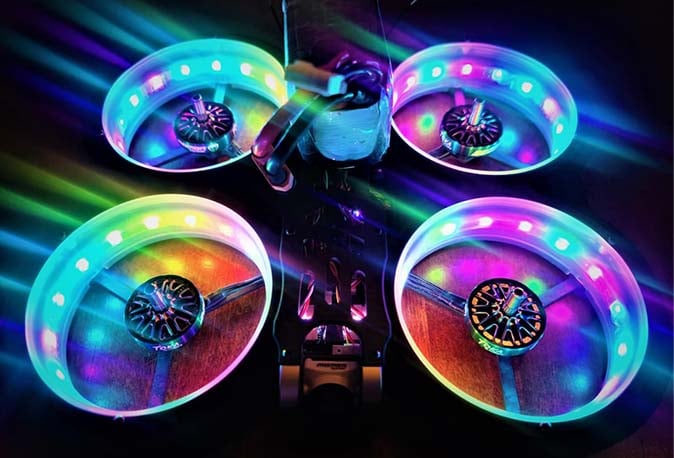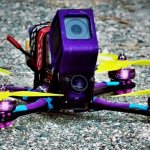Precautions
- Be sure to read the [Safety Precautions] before flying the real FPV drone to ensure the safety of pilots and others!
- The first flight is likely to blow up the quadcopter. Please choose an open and unmanned place. It is recommended to use a ducted FPV quadcopter under 2.5 inches for a test flight.
- Before flying, you need to determine the unlocking method, keep in mind the position of the unlocking switch, and turn off the unlocking as soon as you lose control or crash.
Visual flight practice
1. Preparation before taking off
- Make sure that the structure of the crossing machine is tight and the propeller nuts are not loose.
- Before flying, determine the switch button between the stabilization mode and the manual mode, and make sure to set it to the stabilization mode when taking off for the first time.
- Link the crossover to the remote control.
- Be sure to pay attention to the direction of the crossing plane before taking off, and the tail must be aligned throughout the flight.
2. Stick to the ground flight training
Push the throttle slightly, let the crossover hover at a height of 10-20 cm above the ground, and lightly control the roll and pitch of the fuselage to keep it in its original position.
3. Height control practice and translation practice
Take off and land exercises with the left stick only. until you can take off and land smoothly. Note that the throttle controls the acceleration of the FPV drone rather than the speed, do not push the throttle by a large amount (switch hands).
After controlling the crossover aircraft at a fixed height, try to toggle the right joystick, lightly control the roll and pitch of the fuselage, and make it return to the initial position.
4. Steering practice and tail-to-tail flight practice
Control the left and right joysticks at the same time to make the fuselage turn (Yaw). Follow the tail of the aircraft during the turn and attempt to fly the course (following a fixed path).
5. Manual Mode Exercise (Optional)
Try doing the above in manual mode. It should be noted that in the manual mode, the joystick needs to be turned back to return to the self-stabilizing state, and the difficulty of route flight will increase sharply.
Practice FPV
FPV can only feel the height and position through the camera, and mastering visual flight is only a necessary condition for an FPV. There are also some differences between simulator flight and real drone flight. For the first time, make sure that the venue is open, and the pilot should keep three meters away from the flight site and be equipped with necessary safety measures.
1. Preparation before taking off
Match the frequency of the FPV glasses to clearly display various information in the OSD, such as battery level, flight status, etc., and plan the flight time reasonably.
Tilt the head camera at a small angle (10°~15°) so that you can see ahead when flying at a slow speed.
Place the crossover plane five meters away from the pilot and take off.
2. Height Control Exercise
Get used to feeling the influence of the throttle change on the altitude of the aircraft in the FPV mode, and master the skills of controlling the altitude from the FPV.
3. Stabilizing Mode Exercise
Try a two-hand operation, push the stick slowly, and control the fuselage to adjust the posture slowly. Familiarize yourself with the sense of spatial distance in first-view mode. After you are proficient in flying, try to circle objects, figure 8 flying, and other actions.
4. Manual Mode Exercise
After self-stabilizing mode can achieve stable flight along a fixed path, you can try to find a suitable open outdoor venue and switch to manual mode. The training process is roughly the same as the simulator.
5. Take-off and landing practice
Since the camera of the traversing plane can only provide a front view, it is difficult to determine the distance under the fuselage when landing, and it is difficult to take off and land vertically. You can try to approach and get a view of the landing site, turn the direction 180 degrees, and land slowly.
common problem
1. Offset when taking off in the stabilized mode
Most take-off offsets are due to miscalibration of the accelerometer of the quadcopter. You can refer to the leveling section in the Betaflight tutorial.
2. The motor has abnormal noise
First of all, you need to identify the motor with abnormal noise, the method is as follows:
- The abnormal noise of the motor is usually accompanied by heat, which can be distinguished by touching the rotor of each motor immediately after the flight.
- After the throttle is hit to the lowest level and unlocked, carefully avoid the propellers, hold the crossover machine tightly in your hand, tilt forward, backward, left, and back respectively, and distinguish the abnormal motor by the sound.
- After connecting the battery, connect the drone to the computer and start Betaflight. Push each motor in turn in the setting interface to distinguish.
Although the indoor unit is less dangerous, it is still necessary to take care to hold the traversing machine in your hand when starting the motor. Start each motor separately to determine the source of the abnormal noise.
- The causes and solutions for abnormal noise of the motor are as follows:
- Observe whether the blade is bent, break the blade back in place, or replace it with a new blade.
Make sure that the shaft is not deformed, if it is deformed, you need to replace the motor or top rotor.



